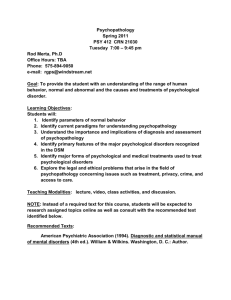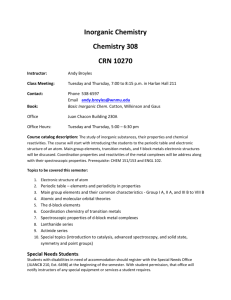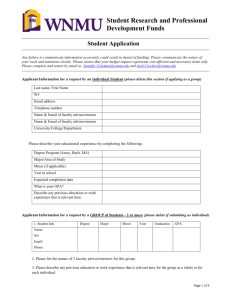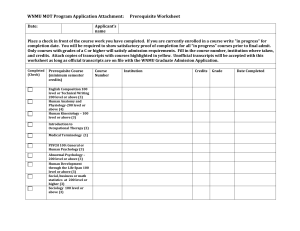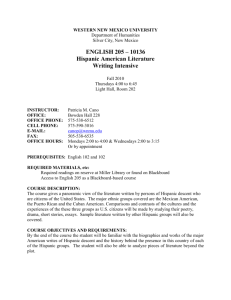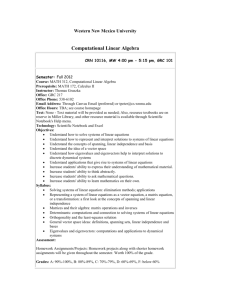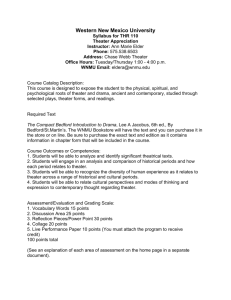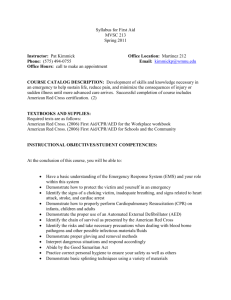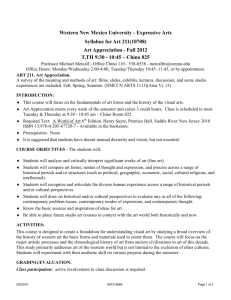ECON 202 30023 - Western New Mexico University
advertisement
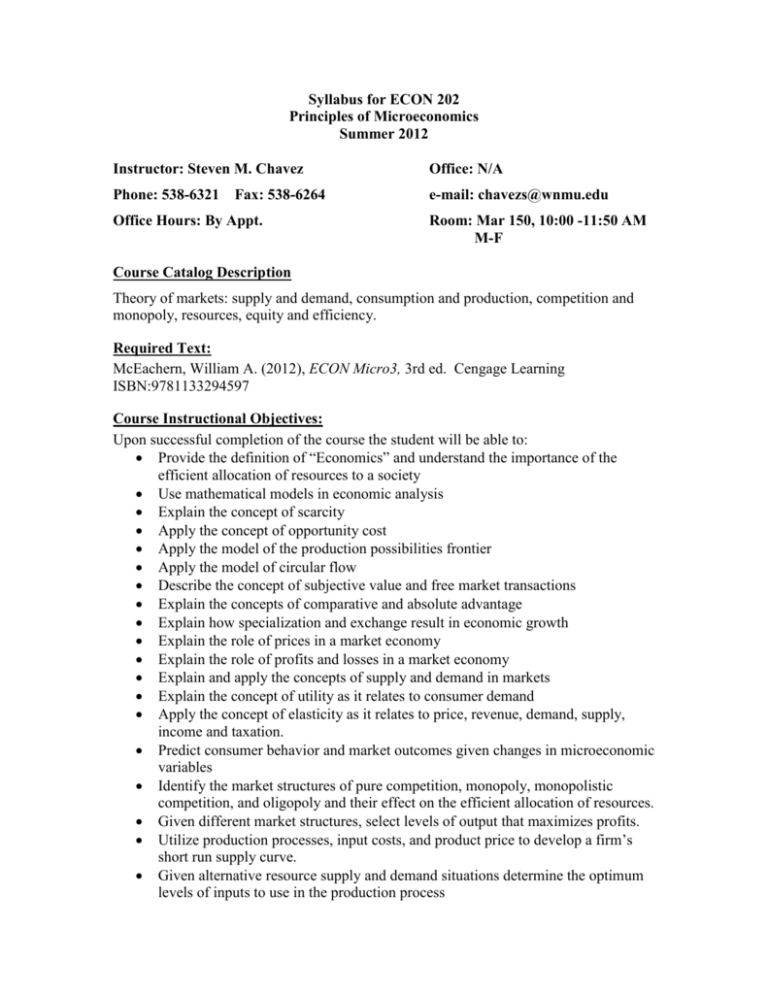
Syllabus for ECON 202 Principles of Microeconomics Summer 2012 Instructor: Steven M. Chavez Office: N/A Phone: 538-6321 e-mail: chavezs@wnmu.edu Fax: 538-6264 Office Hours: By Appt. Room: Mar 150, 10:00 -11:50 AM M-F Course Catalog Description Theory of markets: supply and demand, consumption and production, competition and monopoly, resources, equity and efficiency. Required Text: McEachern, William A. (2012), ECON Micro3, 3rd ed. Cengage Learning ISBN:9781133294597 Course Instructional Objectives: Upon successful completion of the course the student will be able to: Provide the definition of “Economics” and understand the importance of the efficient allocation of resources to a society Use mathematical models in economic analysis Explain the concept of scarcity Apply the concept of opportunity cost Apply the model of the production possibilities frontier Apply the model of circular flow Describe the concept of subjective value and free market transactions Explain the concepts of comparative and absolute advantage Explain how specialization and exchange result in economic growth Explain the role of prices in a market economy Explain the role of profits and losses in a market economy Explain and apply the concepts of supply and demand in markets Explain the concept of utility as it relates to consumer demand Apply the concept of elasticity as it relates to price, revenue, demand, supply, income and taxation. Predict consumer behavior and market outcomes given changes in microeconomic variables Identify the market structures of pure competition, monopoly, monopolistic competition, and oligopoly and their effect on the efficient allocation of resources. Given different market structures, select levels of output that maximizes profits. Utilize production processes, input costs, and product price to develop a firm’s short run supply curve. Given alternative resource supply and demand situations determine the optimum levels of inputs to use in the production process Evaluation and Grading Scale The following grading scale will be used for the course requirements: Quizzes 40% Homework 40% Final exam 20% The grades in this course are A,B,C,D, and F. The final letter grade is determined by the percentage accumulated at the completion of all coursework, as follows: 90-100% 80-89% 70-79% 60-69% 59% or below =A =B =C =D =F Quizzes: Two quizzes will be given daily in this course. The first quiz of the day will be a single question quiz given promptly at 10:00 AM. The first quiz question will be based on information from the previous day’s lesson. The second quiz of the day will be given just prior to the end of class. It will consist of 5 to 10 multiple choice questions from the current day’s lesson. The first quiz of the day is closed notes and book. The second quiz of the day is open notes and book. Make-up quizzes will be given at the discretion of the instructor and only for extenuating circumstances. Quizzes will be graded on a 100 point scale. The two quizzes will be combined for grading. Homework: Two to three short homework assignments will be given at the beginning of each week. These may vary from question and answer, to topic worksheets, essay questions to internet research etc. The homework assignments will be due the following Monday. Late assignments will not be accepted unless extenuating circumstances exist as determined by the instructor. Homework will be graded on a 100 point scale. Final Exam: The Final Exam may consist of multiple-choice, matching, true false, and/or short answer questions. Final Exam: August 7, 10:00 AM Other expectations Punctuality: This course meets Monday through Friday at 10:00 AM. Please make a habit of doing whatever is required to arrive on time. Quizzes will be given promptly at 10:00 AM. If you are late you will miss the first quiz of the day. Attendance: Class absences are noted and may result in class dismissal if the absences interfere with successful meeting of the requirements of the course in accordance with WNMU policy. When absences are required, students must advise the instructor ahead of time. No work or exams may be made up if prior notification of absence is not made. Exceptions for legitimate emergency circumstances may be made at the discretion of the instructor. This course will rely heavily on class presentations that may not be reflected in assigned reading materials. Therefore, it is important to attend class regularly in addition to reading assigned material. Cellular Phones: As useful as cell phones are, they unfortunately often become a problem in class. Cell phones must be turned off at the beginning of class. If you have a legitimate reason for needing your cell phone on (i.e. kids at home etc.) please discuss this with the instructor. Disability Services at Western New Mexico University: Services for students with disabilities are provided through the Academic Support Center’s Disability Support Services Office in the Juan Chacon Building, Room 220. Some examples of the assistance provided are: audio materials for the blind or dyslexic, note takers, readers, campus guides, audio recorders, a quiet testing area, and undergraduate academic tutors (available to all WNMU students). In order to qualify for these services, documentation must be provided by certified health care professionals. Disability Support Services forms are available in the Academic Support Center. The Disability Support Services Office, in conjunction with the Academic Support Center, serves as Western New Mexico University’s liaison for students with disabilities. The Academic Support Center’s Disability Support Services Office can be contacted by phone at (575) 538-6400 or e-mail at dss@wnmu.edu. Communication Policy Statement regarding official email: WNMU’s policy requires that all official communication be sent via Mustang Express. As a result, all emails related to your enrollment at WNMU will be sent to your wnmu.edu email address. All communication concerning this class will be made through Canvas e-mail. It is very important that you access your Mustang Express e-mail periodically to check for correspondence from the University. If you receive most of your email at a different address you can forward your messages from Mustang Express to your other address. Example: Martin Classmember was assigned a WNMU email address of classmemberm12@wnmu.edu but Martin would rather receive his emails at his home email address of martinclass@yahoo.com Martin would follow the direction provided at http://www.wnmu.edu/campusdocs/direction%20for%20forwarding%20email.htm WNMU Policy on Email Passwords: WNMU requires that passwords for access to all of the protected software, programs, and applications will be robust, including complexity in the number of characters required, the combination of characters required, and the frequency in which passwords are required to be changed. Minimum complexity shall include: Passwords shall contain at least six (6) characters. Passwords shall contain at least one capital (upper case) letter, and at least one symbol (numbers and characters such as @ # $ % & *). Passwords shall be changed at least every 90 days. (8/6/08) Academic Integrity Policy and Procedures: Each student shall observe standards of honesty and integrity in academic work as defined in the WNMU catalog. Violations of academic integrity include “any behavior that misrepresents or falsifies a student’s knowledge, skills or ability with the goal of unjustified or illegitimate evaluation or gain” (WNMU Faculty Handbook, 2011). Generally violations of the academic integrity include cheating and plagiarism. Refer to the catalog pages 60-61 for definitions. Penalties for infractions of academic integrity in this class are as follows: Plagiarism: “the intentional or unintentional representation of another’s work as one’s own without proper acknowledgement of the original author or creator of the work” (WNMU Faculty Handbook, 2011). First Offense: Failing grade for the assignment (i.e. zero, no credit) Second Offense: Failing grade for the course. Cheating: “using or attempting to use unauthorized materials…and unauthorized collaboration with others, copying the work of another or any action that presents the work of others to misrepresent the student’s knowledge” (WNMU Faculty Handbook, 2011). Any Offense: Failing grade for the course The instructor reserves the right to revise this syllabus as necessary. Students will be advised of any changes. It is the ultimate responsibility of the student to be aware of changes made to the syllabus. Course Schedule Week 1 July 9- Introduction- Syllabus –Getting Ready to Study Economics- Definition of Economics-, Predicting Average Behavior, Mathematical models (Understanding Graphs)- Using Excel (Read Chapter 1, Including Appendix) July 10- Scarcity, Resources-, Goods and Services- Subjective Theory of Value and the Market Transaction- Art and Science of Economic Analysis, Rational Self Interest Assumption, Opportunity costs, sunk costs, the production possibilities frontier. (Read Chapter 2). July 11- Economic decision makers, Circular flow model, absolute and comparative advantage-Specialization and exchange develop the market economy The 3 questions, Economic systems, Building wealth, (Read Chapter. 3) July 12- Demand defined, the law of demand, the demand schedule, the demand curve, the determinants of demand (Read Chapter. 4 pg. 50-56) July 13- The determinants of demand and shifts in the demand curve- Classroom application exercises. Supply defined, the law of supply, the supply schedule, the supply curve, the determinants of supply and shifts in the supply curve (Read Ch. 4 pg. 56-60) Week 2 July 16- The determinants of supply and shifts in the supply curve, Classroom application exercises- shifts in the supply curve, demand and supply- chasing equilibrium July 17- The role of prices, Disequilibrium, Price floors and price ceilings, Shortage and surplus (Read Chapter. 4 pg. 60-62) July 18- Classroom application exercises- Demand and Supply analysis July 19- Price Elasticity of Demand- Relationship between demand, price elasticity and total revenue, determinants of price elasticity of demand. Price Elasticity of Supply, Income elasticity, Elasticity and tax incidence, Pricing decisions and elasticity (Read Chapter. 5) July 20- Consumer Choice- Utility, marginal utility, Diminishing marginal utility, Consumer surplus, Pricing strategies and consumer surplus (Read Chapter 6) Week 3 July 23- Short run production-exercise. July 24- The role of profits and losses- Explicit and implicit costs, Economic and accounting profits, Production in the short run, Law of diminishing marginal returns The 3 phases of production (Read Chapter 7 pg. 97-101) July 25- Costs in the short run, Fixed and variable cost, Total, marginal, and average cost curves. The supply curve, Costs in the long run and economies and diseconomies of scale (Read Chapter 7 pg. 101-109) July 26- Market structure defined, Perfect competition defined, Demand under perfect competition, Marginal revenue defined, The golden rule of profit maximization, Economic profit in the short run (Read Chapter 8 pg. 110-115) July 27- The short run supply curve and the shutdown point, Short run profit max and market equilibrium, Long run zero economic profit, Long run adjustment to change in demand, Efficiency (Read Chapter 8 pg. 116-128) Week 4 July 30- Monopoly defined, Barriers to entry, Demand under monopoly, Revenue Profit max under monopoly, Production decisions, Long run economic profits, Social impact of monopoly as compared to perfect competition, Deadweight loss, Price discrimination. (Read Chapter 9) July 31- Monopolistic competition Oligopoly- game theory. (Read Chapter 10) Aug 1- Resource and Labor Markets (Read Chapters 11 and 12) Aug 2- Transaction costs, Imperfect Information, Behavioral Economics- (Read Chapter 14) Market failure, government regulations: natural monopolies, anti-trust laws, (Read Chapter 15). Aug 3- Government intervention: public goods (Read Chapter 16) Externalities and the Environment (Read Chapter 17) Week 5 Aug 6- Final Exam Review Aug 7- Final Exam
